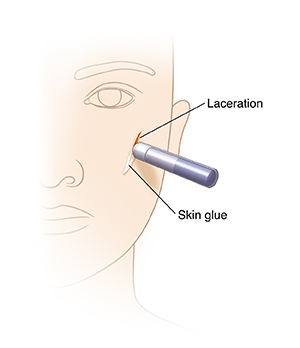A laceration is a cut through the skin. A laceration on your face has been closed with skin glue. This is used on cuts that have smooth edges that can be brought together easily and are not infected. Skin glue is best used on clean, straight cuts on the face in areas that don't get a lot of tension. In some cases, a lower layer of skin may be stitched closed before skin glue is put on. The skin glue closes the cut within a few minutes. It also provides a water-resistant cover. No bandage is needed. Skin glue peels off on its own within 5 to 10 days.
Home care
-
Follow all instructions for taking medicines.
-
Your healthcare provider may prescribe an antibiotic. This is to help prevent infection. Take the medicine every day until it's gone—even if you are feeling better—or you are told to stop. You should not have any left over.
-
The healthcare provider may prescribe medicines for pain. Use them as directed.
-
-
Follow the healthcare provider’s instructions on how to care for the cut.
-
Keep the wound clean and dry. You may shower or bathe as usual, but don't use soaps, lotions, or ointments on the wound area, as they may dissolve the glue. Don't scrub the wound. After bathing, pat the wound dry with a soft towel. Don't soak the cut in water for 7 to 10 days.
-
Don't scratch, rub, or pick at the film. Don't place tape directly over the film.
-
Don't apply liquids such as peroxide, ointments, or creams to the wound while the film is in place.
-
Watch for the signs of infection that are listed below. Most facial skin wounds heal without problems. But an infection sometimes occurs despite proper treatment.
-
While the glue is in place, keep the wound out of prolonged direct sunlight, especially in the summer months. After the glue falls off, continue to stay out of direct sunlight, or use a sunscreen with a high level of protection. Sunburn or sun exposure can increase scarring.
Follow-up care
Follow up with your healthcare provider, or as advised. If skin glue was used, the film will fall off by itself in 5 to 10 days.
When to get medical advice
Call your healthcare provider right away if any of these occur:
-
Wound bleeding more than a small amount or bleeding doesn't stop
-
Decreased movement around the injured area
-
Signs of infection:
-
Increasing pain in the wound
-
Increasing wound redness or swelling
-
Pus or bad odor coming from the wound
-
Fever of 100.4°F (38ºC) or higher, or as directed by your healthcare provider
-
Chills
-
-
Wound edges reopening
-
Lots of itching
-
Skin blisters


